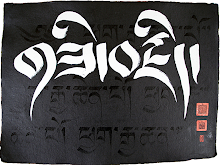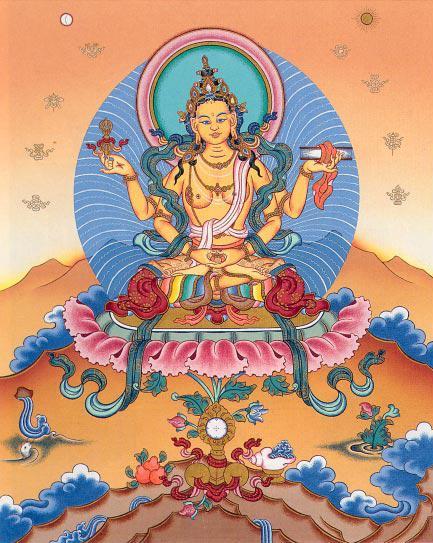A teaching on the nature of mind by the late Dilgo Khyentse Rinpoche
The great pandit Shantarakshita, who was instrumental in transplanting Buddhism from India to Tibet, promised that one of his students would come one day to complete his work. Kamalasila (Tib., Padampa Sangye) fulfilled this prophecy, making three trips to Tibet during the eleventh century. This was the time when the great yogi Milarepa lived, and his autobiography describes a momentous dharma debate between the two teachers.
The story behind the teaching presented here begins when Padampa Sangye throws a stone magically bestowed upon him by the Buddha, saying that he would teach wherever it landed. The stone landed in the village of Tingri, in Tibet, and true to his word, Padampa Sangye founded his monastic seat there and proclaimed The Hundred Verses of Advice to the villagers.
Translator Matthieu Ricard requested that his teacher, Dilgo Khyentse Rinpoche (1910-1991), considered an emanation of Padampa Sangye, offer a commentary on these pithy verses. A renowned Dzogchen master, Khyentse Rinpoche spent most of his early life in solitary retreat in mountain caves. He studied and taught tirelessly for many decades, influencing scores of teachers and thousands of students. He made several important teaching tours to Europe and North America and his works have been translated into many Western languages. In his final years, he was head of the Nyingma lineage.
Khyentse Rinpoche offered this commentary in 1987 to a gathering of students at Shechen Monastery, his seat in Nepal. John Canti of the Padmakara Translation Group translated Padampa Sangye’s verses into English. Matthieu Ricard provided the translation of Khyentse Rinpoche’s commentary. The entire one hundred verses succinctly survey the path. They begin with the miserableness of all aspects of samsara and the unavoidability of karma and death and end with the means of achieving enlightenment. The verses excerpted below, numbers 51 to 69, expound on the limitless nature of mind.
In a state of emptiness, whirl the spear of pure awareness;People of Tingri, the view is free of being caught by anything at all.Our realization, our view, should be as high and vast as the sky. Once the awakening of pure awareness arises within the vortex of emptiness, conflicting emotions can no longer obscure it, but instead become its ornaments.
The unalterable realization of this view, which has no birth, duration or cessation, is accompanied by an enlightened consciousness that observes the movement of thoughts as a serene old man regards children playing. Confused thoughts cannot affect pure awareness any more than a sword can pierce the sky.
Lady Peldarbum said to Milarepa:
When I meditated on the ocean,
My mind was very comfortable.
When I meditated on the waves,
My mind was troubled.
Teach me to meditate on the waves!
The great yogi responded:
The waves are the movement of the ocean.
Leave them to calm themselves in its vastness.
Thoughts are the play of pure awareness. They arise within it and dissolve back into it. To recognize pure awareness as the very source of thought is to recognize that our thoughts have never begun, continued or ceased to exist. At that point, thoughts can no longer trouble the mind.
As long as we run after our thoughts, we are like a dog chasing a stick. Each time we throw the stick, he runs after it. If we look at the enlightened consciousness instead, the source of our thoughts, we will see that each thought arises and dissolves in the space of that consciousness, without engendering other thoughts. Then we will be like a lion, which does not chase after the stick, but turns to face the thrower. You can throw a stick at a lion only once.
To conquer the uncreated citadel of the nature of mind, we must go to the source and recognize the origin of thoughts. Otherwise, one thought gives rise to a second, then a third, and so on. We will be constantly assailed by memories of the past and anticipation of the future, and will lose the pure awareness of the present moment.
A story is told of a practitioner who was giving some rice he had offered on his altar to the pigeons one day, when he suddenly remembered the numerous enemies he had had before devoting himself to the dharma, and conceived this disastrous thought: "If I had had as many soldiers then as I have pigeons at my door now, I could have easily wiped out my enemies." This idea obsessed him until he could no longer control his hostility, and he left his hermitage and assembled a band of mercenaries to fight his former enemies, thus committing incalculable misdeeds. And it all began with one simple, deluded thought.
If we recognize the emptiness of our thoughts instead of solidifying them, the arising and subsidence of each thought will clarify and strengthen our realization of emptiness.
In a state without thoughts, without distraction abandon the watcher;People of Tingri, the meditation is free of any torpor or excitement.If our mind dwells in limpid awareness, with no thought of past or future, without being attracted by external objects or occupied by mental constructions, it will dwell in primordial simplicity. In this state, there is no need for the iron hand of forced vigilance to immobilize our thoughts. "Buddhahood," it is said, "is the natural simplicity of the mind."
Having once recognized this simplicity, we should maintain it with effortless presence of mind. Then we will know an inner freedom that has no need to block the arising of thoughts or to fear that they will spoil our meditation.
In a state of natural spontaneity, train in being free of any holding back;People of Tingri, in the action there is nothing to abandon or adopt.Preserve that state of simplicity. If you encounter happiness, success, abundance and other favorable conditions, consider them like dreams, illusions. Do not become attached to them. If we are struck by illness, calumny, deprivation or other physical and moral trials, guard against discouragement, rekindle your compassion, and wish that the sufferings of all beings might be exhausted through your own. Fall neither into elation nor misery, whatever the circumstances. Stay comfortable and free in imperturbable serenity.
The four bodies, indivisible, are complete in your mind;People of Tingri, the fruit is beyond all hope and doubt.The state of buddhahood may seem to be a distant goal, almost beyond attainment, but the natural emptiness of our mind is none other than the “absolute body,” or dharmakaya. Its luminous expression is the “body of perfect endowment,” or sambhogakaya. The universal compassion which emanates from it is the “body of manifestation,” or nirmanakaya. The intrinsic unity of these three bodies is the “essential body,” or svabhavikakaya. These four bodies, or dimensions, of a buddha, have always been present in us. It is only through ignorance of their presence that we consider them as something external and distant.
"Is my meditation correct?" we wonder restlessly. "When am I finally going to make some progress? I'll never attain the level of my spiritual master." Torn between hope and fear, our minds are never at peace.
According to our mood, we practice intensely one day, and the next day not at all. We cling to the agreeable experiences that arise when we attain some mental calm, but feel like abandoning the meditation when we are unable to slow the flood of thoughts. This is not the way to practice meditation.
Whatever our state of mind, we should constrain ourselves to a regular practice, day after day, observing the movement of our thoughts and following them back to their source. We cannot expect to be able to maintain the flow of our concentration day and night all at once.
When we begin to meditate on the nature of the mind, it is preferable to practice in short, frequent sessions. With perseverance, we will progressively realize the nature of our mind, and this realization will become more and more stable. By that point, thoughts will have lost their power to perturb and enslave us.
The root of both samsara and nirvana is to be found within your mind;People of Tingri, the mind is free of any true reality.Our own mind is what leads us astray in the cycle of existence. Blind to its true nature, we fixate on thoughts, which are nothing other than the manifestations of that nature. Pure awareness becomes frozen into solid concepts such as "self" and "other,” "desirable" and "repulsive," and many more. That is how we create samsara.
If we can melt the ice of these fixations by following the instructions of a spiritual master, pure awareness will recover its natural fluidity. Put another way, when we cut a tree at the base, the trunk, branches and leaves all fall at the same time. Similarly, if we cut thoughts off at their source, the delusion of samsara will fall away entirely.
The phenomena of samsara and nirvana appear with the vivid clarity of a rainbow, and like a rainbow they are devoid of any tangible reality. Once we recognize the nature of phenomena, which are manifest and at the same time empty, our mind will be freed from the tyranny of delusion.
In substantive terms, to recognize the ultimate nature of the mind is to realize the state of buddhahood, and failure to recognize it is to sink into ignorance. In either case, it is our mind, and our mind alone, which binds or liberates us.
This does not mean that the mind is an entity that can be worked like clay, to which the potter can give beautiful or ugly forms. When the spiritual master introduces the disciple to the nature of the mind, he isn't pointing to a concrete object. When the disciple seeks and finds that nature, he doesn't lay hands on a graspable entity. To recognize the nature of the mind is to recognize its emptiness. That is all. It is a realization that takes place in the realm of direct experience and cannot be expressed in words.
To expect that this realization will be accompanied by clairvoyance, miraculous powers and other extraordinary experiences is to delude oneself. Let us simply devote ourselves to recognizing the empty nature of the mind!
Desire and hate appear, but like birds in flight should leave no trace behind;People of Tingri, in meditation be free of clinging to experiences.Generally speaking, we are strongly attached to our families, to our goods and to our position, and we feel an intense aversion to those who hurt us. So let us turn our attention away from external objects and examine the mind that clings to them. We will agree that desire and anger have neither form nor color nor substance nor locality. If this is so, why do we fall so easily under the power of such thoughts? Ironically, it is because we do not know how to set them free.
If we allow our thoughts to arise and dissolve by themselves, they will pass through our mind as a bird flies through the sky, without leaving a trace. This method applies not only to attachment and anger but also to the experiences of meditation, such as bliss, clarity and the absence of thought. These experiences result from perseverance in practice and the expression of the inherent creativity of the mind. They are like the appearance of a rainbow as the rays of the sun strike a curtain of rain. For us to become attached to them is as vain as running after a rainbow in hopes of wearing it as a coat. We should simply allow thoughts and experiences to come and go, without grasping at them.
The unborn absolute body is like the very heart of the sun;People of Tingri, there is no waxing or waning of its radiant clarity.Emptiness, the ultimate nature of the dharmakaya, the absolute dimension, is not a mere nothingness. It has a luminous cognitive aspect that knows all phenomena and that manifests spontaneously. The dharmakaya is not the product of causes and conditions; it is the original nature of the mind.
The recognition of this primordial nature is like the sun of wisdom rising in the night of ignorance. The darkness dissipates instantly; the shadows cannot remain. The clarity of the dharmakaya does not wax and wane like the moon, but is like the unchangeable brilliance that reigns at the center of the sun.
Thoughts come and go like a thief in an empty house;People of Tingri, in fact there is nothing to be gained or lost.Convinced of the reality of an entity called "I" and its thoughts, we create karma, whether good or bad. In reality, such thoughts are like a thief in an empty house, where the thief has nothing to gain and the owner has nothing to lose. The realization that these thoughts have never really taken birth, and therefore have never existed and cannot cease to exist, renders them harmless. Thoughts liberated in this way as they arise have no impact and bring no karmic effect. There will be nothing to fear from negative thoughts, and nothing to hope for from positive ones.
Sensations leave no imprints, like drawings made on water;People of Tingri, don't perpetuate deluded appearances.We are naturally attached to comfort and pleasure and bothered by physical and moral suffering. These innate tendencies lead us to seek out, maintain and enhance all that will give us pleasure—comfortable clothing, delicious food, agreeable places, the pleasures of the senses—and to avoid or destroy whatever displeases us.
Changing constantly and devoid of essence, the sensations rest on the ephemeral associations of the body and the mind. Becoming attached to them is perfectly futile. Rather than being dragged along, trapped by our perceptions, let them dissolve just as they form, as a letter written by a finger on the surface of the water disappears as it is being drawn.
Thoughts of attachment and aversion are like rainbows in the sky;People of Tingri, there is nothing in them to be grasped or apprehended.We can become so dominated by our cravings and our hatreds that we are ready to sacrifice our lives to appease them. Wars illustrate this well. Our thoughts seem very solid and compelling, but if we examine them more carefully, we find that they have no more substance than a rainbow. Devoting our lives to trying to satisfy our impulses is puerile. Those who hunger for glory, power, pleasures and riches are like young children wanting to grasp a rainbow.
In practical terms, when a desire or a burst of anger inflames your mind, look closely at your thoughts and recognize their fundamental emptiness. These thoughts will dissolve by themselves if you allow them to. If you can do the same with the next thought and with all that follow, they will lose their hold over you.
Mind's movements dissolve by themselves, like clouds in the sky;People of Tingri, in the mind there are no reference points.When banks of clouds build up, the nature of the sky is not affected, and when they disperse, it is not improved. The sky becomes neither more nor less vast or pure; it doesn't change. The nature of the mind is just the same. It is not altered by the arising of thoughts, or by their disappearance.
The nature of the mind is emptiness. The expression of this nature is clarity. These two aspects of the mind can be distinguished for descriptive purposes, but they are essentially one. Fixating just on the notion of "emptiness" or of "clarity," as if these were independent entities, is a mistake. The ultimate nature of the mind is beyond all concepts, definitions and partial views.
A child thinks, "I could walk on the clouds!" If he could actually reach the clouds, however, he would find nowhere to set foot. In the same way, our thoughts appear to be solid until we examine them. Then we find that they are without substance. Thus we say that phenomena are empty and apparent at the same time.
Without fixation, thoughts are freed by themselves, like the wind,People of Tingri, which never clings to any object.The wind blows through the sky and flies over continents without settling anywhere. It traverses space and leaves no trace. Thus should thoughts pass through our minds, leaving no karmic residues and not altering our realization of fundamental simplicity.
Pure awareness is without fixation, like a rainbow in the sky;People of Tingri, experiences arise quite unimpededly.Pure awareness, the enlightened mind, which is none other than the mind liberated of all delusion, transcends even the notions of being and non-being. "Where there is attachment, there is no view," were the words that Jetsun Trakpa Gyaltsen heard from Manjushri, the buddha of wisdom, during a vision. Enlightenment cannot be said to exist, because even the buddhas haven't seen it. Nor can we say that it does not exist, because it is the source of samsara and nirvana. As long as the concepts of being and non-being persist, we have not realized the mind's true nature.
A rainbow sparkles in the sky, but it is nothing other than the sky itself. You could call it a manifestation of the sky. Likewise, the experiences that arise during meditation have no substance. Good experiences make us suppose that we have attained lofty realization; bad ones discourage us. It is truly said: "Children are lured by a rainbow, meditators by their experiences." If we attach no importance to them they cannot dupe us.
Realization of the absolute nature is like the dream of a mute;People of Tingri, there are no words to express it.A mute might clearly remember a beautiful dream but cannot express it in words. Likewise, we lack words to describe the ultimate nature of the mind, the dharmakaya, since the mind escapes all definitions. If we say it exists, we have nothing to show for it but emptiness. If we say it is nothing at all, we are refuted by its myriad manifestations. The ultimate nature of the mind pertains to the domain of absolute truth, which defies all description and cannot be grasped by discursive thought.
Realization is like a youthful maiden's pleasure;People of Tingri, the joy and bliss just cannot be described.With the dawn of realization, the mind becomes perfectly free, at ease, fulfilled, vast and serene. This realization, however, is inexpressible, like the joy of an adolescent in the flower of youth.
Clarity and emptiness united are like the moon reflected in water;People of Tingri, there is nothing to be attached to and nothing to impede.The perceptions of samsara and nirvana are simply the play of the mind's natural creativity, the radiance of its emptiness. The essence of this radiance is emptiness, and the expression of emptiness is radiance. They are indivisible.
Take the moon reflected on the surface of a lake as an example. It is brilliantly apparent, but you cannot trap it. It is vividly present and at the same time utterly intangible. The same is true of the mind. By its very nature, which is the indivisible union of emptiness and luminosity, nothing can obstruct it and it can obstruct nothing, unlike a solid object, such as a rock, with a physical, exclusive presence. In essence, the mind is insubstantial and omnipresent.
Appearances and emptiness inseparable are like the empty sky;People of Tingri, the mind is without either center or periphery.The mind has the faculty of apprehending forms, sounds and other phenomena, of experiencing happiness and suffering. Yet the world of appearances has never existed in itself. When you analyze it, nothing is there but emptiness. Just as space is the condition allowing worlds to unfold, the empty nature of the mind is the condition through which it can express itself. Space is without limits; no center or periphery can be assigned to it. Likewise, the mind has neither beginning nor end, neither in time nor in space.
The mind with no thought and no distraction is like the mirror of a beauty;People of Tingri, it is free of any theoretical tenets.Once the nature of the mind has been recognized, we no longer need to constrain ourselves to a conscious recollection of that nature, nor to modify it in any way. At that point, the mind cannot even be said to "meditate," because it rests in a state of serene equilibrium. There is no specific concentration on the details of a particular visualization, such as the form of a deity; neither will the mind stray into the distraction and delusion that characterize the ordinary state, because it rests perpetually and effortlessly in its own nature.
Pure awareness is not affected by agreeable or disagreeable perceptions. It simply stays as it is, like a mirror, neither enraptured by a beautiful face nor offended by ugliness. Just as a mirror reflects all images faithfully and with absolute impartiality, an enlightened being clearly perceives all phenomena, without his or her realization of the ultimate nature being affected in the least.
One can neither say that an image on the surface of a mirror is a part of the mirror nor that it is anywhere else. In the same way, our perceptions of phenomena are neither in the mind nor outside it.
The realization of the ultimate nature of things is beyond the concepts of being and non-being. Thus Nagarjuna said in the Root Scripture of the Middle Way: "Because I affirm nothing, none can refute my point of view."
Awareness and emptiness inseparable are like reflections in a mirror;People of Tingri, nothing is born there and nothing ceases.The emptiness of the mind is neither nothingness nor a state of torpor, because it naturally possesses a luminous faculty of knowing, what we call pure awareness or enlightened consciousness. The aspects of emptiness and awareness are essentially one, like the surface of a mirror and the reflection in it.
Thoughts manifest within emptiness and are reabsorbed there, as a face appears and disappears in a mirror. Since the face has actually never been in the mirror, it does not cease to be when it is no longer reflected there, while the mirror itself has never changed.
Before entering the spiritual path, we dwell in the supposedly impure state of samsara, which is governed, in relative terms, by ignorance. When we are engaged on the path, we pass through a state where ignorance and knowledge are mixed, and at the end of the path, at the moment of awakening, nothing remains but pure awareness. But throughout the entire course, though it appears that a transformation has taken place, the nature of the mind itself has never changed; not corrupted at the beginning of the path, it is not improved at the end.


















































.jpg)






